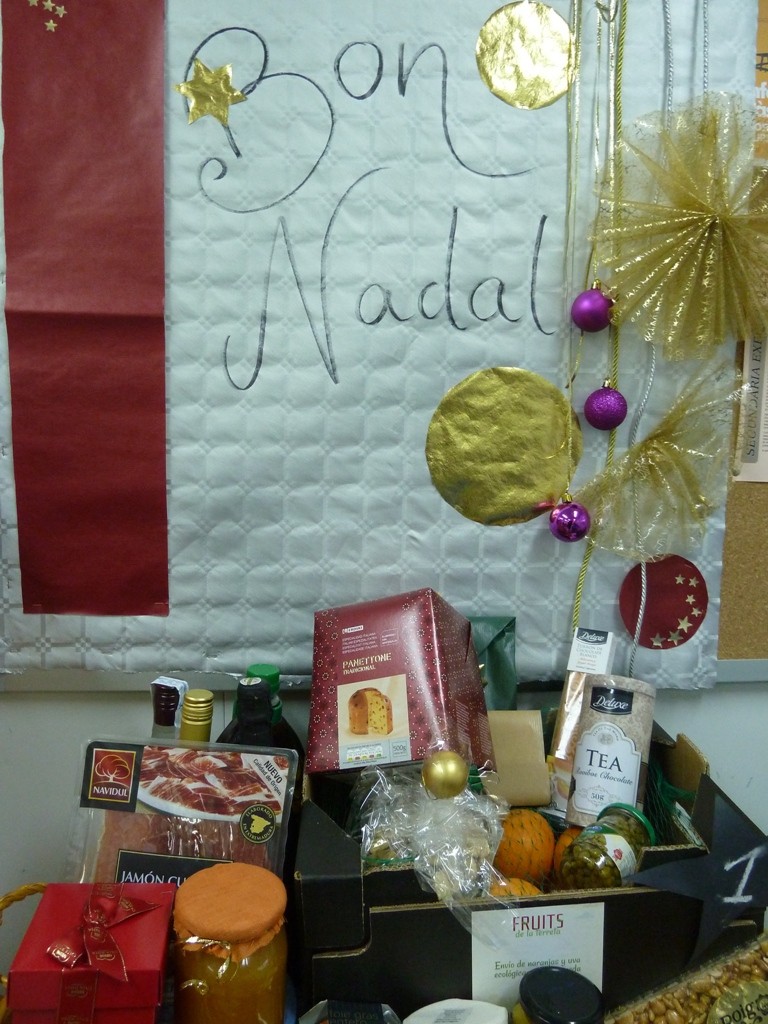Spanish Christmas time traditions
If one the one hand it is true that, echoing a well known Italian popular saying, the 6th of January carries away all the holiday atmosphere, on the other hand it is a good occasion to make a balance of the days elapsed in Christmas time. Undeniably a special period of the year, this time it has been all the more special for me, given that I have spent the first time of it abroad before coming back home. This fact allowed me to become familiar with some aspects of the Spanish (and Catalan) Christmas time traditions, part of which I could give direct account.

It all started with a bunch of colourful sweets which appeared in the supermarket at the beginning of December, quite to my scorn because they replaced my favourite breakfast cake. My flat mate finally revealed me that they were called polvorones, one of the typical Spanish Christmas sweets. After tasting them, my initial aversion soon turned into unconditioned appreciation. Despite their reduced size, indeed, I found polvorones really delicious, probably due to their weird, crumbly consistence (I guess they are called like that because they may be easily crushed to dust) and their aroma. Not by chance, when I went back to Italy my bag was quite full ot them!

The next step in my familiarization with the local tradition was taking part in a bingo game which raffled a wonderful basket of groceries (a typical Christmas gift for important person in Italy as well). Maybe I should refresh my memory, but I think it was called rifa or something of that sort. Being a Christmas traditional game in the Catalan family, it was decided that we were to play it as well after the teachers Christmas lunch. Therefore, everybody took part in the preparation of the basket, contributing with a special product of their homeland. Of course, I was not among the lucky ones (and it was not due to the fact that I did not understand Catalan numbers, as someone dared saying). Anyway, it was funny to take part in it, also because I had to wear what was supposed to be a traditional Catalan Christmas cap of a strange violet colour.

Back home, I waited for the day of the National Lottery without much hope (as I have explained in a specific entry) and then Christmas came by leaps and bounds. I was explained that most families in Spain celebrate on Christmas' Eve with a special family dinner, normally based on fish and typical dishes. Nochebuena (literally "Good Night", probably referring to the "Holy Night") is the Spanish name of this special moment. After dinner, some families attend the Holy Mass (called Misa del Gallo because it is celebrate during the night), some others just exchange gifts and sing typical Christmas carols, which are called villancicos in Spanish.
On Christmas Day (Navidad), the routine is basically the same: those who have not celebrated inNochebuena will have a merry time with a special lunch. In Italy, we have a similar tradition, but this year the Christmas lunch ended in a different way for my family, as together with our typical desserts (Pampapato, Pandoro, Panettone), turrón was also brought to the table. As a matter of fact, I had been pestering my family for days because I was looking forward to taste this Spanish specialty. In Italy, indeed, we are quite accustomed to eat a hard kind of torrone (nougat), while the soft Turròn de Jijona, prepared with honey, sugar, almond or nuts has been a pleasant discovery.

In Spain (as in Italy, after all) there is no such tradition as the British Boxing Day, though the 26th of December is a feast day in some regions. Anyway, the Dìa de los Santos Inocentes (of which I have given account in a special entry dating back to the 28th of December) makes up for the loss, though in a very peculiar way. Nochevieja is the name of New Year's Eve, usually spent enjoying with a group of friends. An abundant dinner is normally topped by a strange sort of dessert: in Spain, indeed, it is common to eat 12 grains of grapes right a few seconds before midnight. If you have survived the traditional uvas de la suerte without choking, you may comply with another Spanish ritual, that is eating chocolate con churros at the early hours, before going to bed.
The last (and probably most solemn) moment of the Christmas holidays (Navidades) is the 6th of January, or Día de Reyes. In many parts of Spain, indeed, the biblical tradition is still respected and the Reyes Magos (the Three Wise Men) are still in charge of delivering the gifts which children are looking forward to. For this reason, a parade is normally organized on the evening of the 5th of January, with the three kings marching for the city. On the following day, children usually receive the gifts they have asked for in their letter, together with some sweets (they are supposed to receive some pieces of coal if they have misbehaved, but that does not usually happen). Once again, a solemn family lunch is held to celebrate the end of the Christmas holidays, culminating in a special kind of dessert called Roscòn de Reyes. It is a cake, normally a ring-shaped one, in which a small object (a small doll or dummy) has been hidden. The person in whose slice of cake the object is found, is chosen as the king or queen of the day.

Last but not least... I have not dealt with the typically Catalan symbol of Christmas, probably due to the fact that I find it really horrible and disgusting. Quite to my surprise, indeed, I found that in Christmas time the streets and shop-windows of Catalonia are invaded by the ridiculous figure of a pooping man, called caganer. I did not enquire about its meaning, nor I have understood why this distasteful tradition has gone to the length of producing hordes of statuettes depicting any famous character (from politicians to football players, including even the Pope) depicted in the act of shitting. Of course, I have not thought for a moment of buying such a repugnant souvenir, and among all the interesting traditions I have come to know, this is one I would gladly do without.
Photo gallery
Content available in other languages
- Español: Tradiciones navideñas de España
- Polski: Hiszpańskie bożonarodzeniowe tradycje
Want to have your own Erasmus blog?
If you are experiencing living abroad, you're an avid traveller or want to promote the city where you live... create your own blog and share your adventures!
I want to create my Erasmus blog! →








Comments (0 comments)